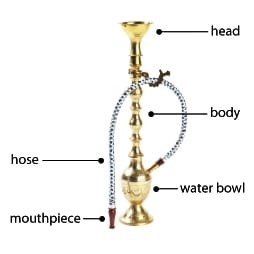Hookahs
Overview
- Hookahs are water pipes that are used to smoke specially made tobacco that comes in different flavors, such as apple, mint, cherry, chocolate, coconut, licorice, cappuccino, and watermelon.1,2
Hookah Use
- Hookah use began centuries ago in ancient Persia and India.1,2,3,4
- Today, hookah cafés are gaining in popularity around the world, including Britain, France, Russia, the Middle East, and the United States.1
- Hookah use by youth1,2,3 and college students is increasing.5
- In 2010, the Monitoring the Future survey found that among high school seniors in the United States, about 1 in 5 boys (17%) and 1 in 6 girls (15%) had used a hookah in the past year.5
- Other small studies of young adults have found high prevalence of hookah use among college students in the United States. These studies show past-year use ranging from 22% to 40%.5
- New forms of electronic hookah smoking, including steam stones and hookah pens, have been introduced.
- These products are battery powered and turn liquid containing nicotine, flavorings, and other chemicals into a vapor, which is inhaled.6
- Very little information is currently available on the health risks of electronic tobacco products.6
Health Effects
Hookah Smoke and Cancer
- The charcoal used to heat the tobacco can raise health risks by producing high levels of carbon monoxide, metals, and cancer-causing chemicals.1,4
- Even after it has passed through water, the smoke from a hookah has high levels of these toxic agents.4
- Hookah tobacco and smoke contain several toxic agents known to cause lung, bladder, and oral cancers.1,4
- Tobacco juices from hookahs irritate the mouth and increase the risk of developing oral cancers.4,7
Other Health Effects of Hookah Smoke
- Hookah tobacco and smoke contain many toxic agents that can cause clogged arteries and heart disease.1,4
- Infections may be passed to other smokers by sharing a hookah.2
- Babies born to women who smoked water pipes every day while pregnant weigh less at birth (at least 3½ ounces less) than babies born to nonsmokers.5,8
- Babies born to hookah smokers are also at increased risk for respiratory diseases.8
Hookah Smoking Compared With Cigarette Smoking
- While many hookah smokers may think this practice is less harmful than smoking cigarettes, hookah smoking has many of the same health risks as cigarette smoking.1,2
- Water pipe smoking delivers nicotine—the same highly addictive drug found in other tobacco products.2
- The tobacco in hookahs is burned (exposed to high heat) and the smoke is at least as toxic as cigarette smoke.1,2
- Because of the way a hookah is used, smokers may absorb more of the toxic substances also found in cigarette smoke than cigarette smokers do.1,2
- An hour-long hookah smoking session involves 200 puffs, while smoking an average cigarette involves 20 puffs.1,2
- The amount of smoke inhaled during a typical hookah session is about 90,000 milliliters (ml), compared with 500–600 ml inhaled when smoking a cigarette.4
- Hookah smokers may be at risk for some of the same diseases as cigarette smokers. These include:3,4
- Oral cancer
- Lung cancer
- Stomach cancer
- Cancer of the esophagus
- Reduced lung function
- Decreased fertility
Hookahs and Secondhand Smoke
- Secondhand smoke from hookahs can be a health risk for nonsmokers. It contains smoke from the tobacco as well as smoke from the heat source (e.g., charcoal) used in the hookah.1,5,9
Nontobacco Hookah Products
- Some sweetened and flavored nontobacco products are sold for use in a hookah.10
- Labels and ads for these products often claim that users can enjoy the same taste without the harmful effects of tobacco.10
- Studies of tobacco-based shisha and “herbal” shisha show that smoke from both preparations contain carbon monoxide and other toxic agents known to increase the risks for smoking-related cancers, heart disease, and lung disease.10,11
References
For Further Information
Centers for Disease Control and Prevention
National Center for Chronic Disease Prevention and Health Promotion
Office on Smoking and Health
E-mail: tobaccoinfo@cdc.gov
Phone: 1-800-CDC-INFOMedia Inquiries: Contact CDC's Office on Smoking and Health press line at 770-488-5493.

No comments:
Post a Comment